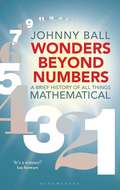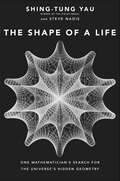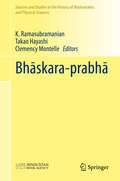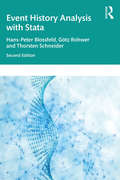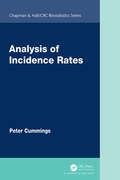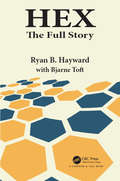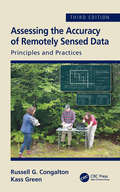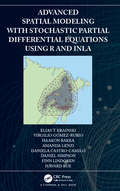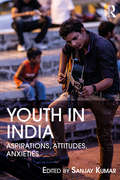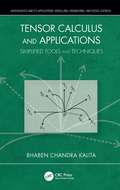- Table View
- List View
Everybody Lies: The New York Times Bestseller
by Seth Stephens-DavidowitzTHE NEW YORK TIMES BESTSELLERAN ECONOMIST BOOK OF THE YEARA NEW STATESMAN BOOK OF THE YEAR'This book is about a whole new way of studying the mind ... Endlessly fascinating' Steven Pinker'A whirlwind tour of the modern human psyche' EconomistEverybody lies, to friends, lovers, doctors, pollsters – and to themselves. In Internet searches, however, people confess the truth.Insightful, funny and always surprising, Everybody Lies explores how this huge collection of data, unprecedented in human history, could just be the most important ever collected. It offers astonishing insights into the human psyche, revealing the biases deeply embedded within us, the questions we're afraid to ask that might be essential to our well-being, and the information we can use to change our culture for the better.
The Cult of Statistical Significance: How the Standard Error Costs Us Jobs, Justice, and Lives (Economics, Cognition, And Society)
by Deirdre Nansen McCloskey Steve Ziliak“McCloskey and Ziliak have been pushing this very elementary, very correct, very important argument through several articles over several years and for reasons I cannot fathom it is still resisted. If it takes a book to get it across, I hope this book will do it. It ought to.” —Thomas Schelling, Distinguished University Professor, School of Public Policy, University of Maryland, and 2005 Nobel Prize Laureate in Economics “With humor, insight, piercing logic and a nod to history, Ziliak and McCloskey show how economists—and other scientists—suffer from a mass delusion about statistical analysis. The quest for statistical significance that pervades science today is a deeply flawed substitute for thoughtful analysis. . . . Yet few participants in the scientific bureaucracy have been willing to admit what Ziliak and McCloskey make clear: the emperor has no clothes.” —Kenneth Rothman, Professor of Epidemiology, Boston University School of Health The Cult of Statistical Significance shows, field by field, how “statistical significance,” a technique that dominates many sciences, has been a huge mistake. The authors find that researchers in a broad spectrum of fields, from agronomy to zoology, employ “testing” that doesn’t test and “estimating” that doesn’t estimate. The facts will startle the outside reader: how could a group of brilliant scientists wander so far from scientific magnitudes? This study will encourage scientists who want to know how to get the statistical sciences back on track and fulfill their quantitative promise. The book shows for the first time how wide the disaster is, and how bad for science, and it traces the problem to its historical, sociological, and philosophical roots. Stephen T. Ziliak is the author or editor of many articles and two books. He currently lives in Chicago, where he is Professor of Economics at Roosevelt University. Deirdre N. McCloskey, Distinguished Professor of Economics, History, English, and Communication at the University of Illinois at Chicago, is the author of twenty books and three hundred scholarly articles. She has held Guggenheim and National Humanities Fellowships. She is best known for How to Be Human* Though an Economist (University of Michigan Press, 2000) and her most recent book, The Bourgeois Virtues: Ethics for an Age of Commerce (2006).
Wonders Beyond Numbers: A Brief History of All Things Mathematical
by Johnny BallIn this book, Johnny Ball tells one of the most important stories in world history – the story of mathematics. By introducing us to the major characters and leading us through many historical twists and turns, Johnny slowly unravels the tale of how humanity built up a knowledge and understanding of shapes, numbers and patterns from ancient times, a story that leads directly to the technological wonderland we live in today. As Galileo said, 'Everything in the universe is written in the language of mathematics', and Wonders Beyond Numbers is your guide to this language. Mathematics is only one part of this rich and varied tale; we meet many fascinating personalities along the way, such as a mathematician who everyone has heard of but who may not have existed; a Greek philosopher who made so many mistakes that many wanted his books destroyed; a mathematical artist who built the largest masonry dome on earth, which builders had previously declared impossible; a world-renowned painter who discovered mathematics and decided he could no longer stand the sight of a brush; and a philosopher who lost his head, but only after he had died. Enriched with tales of colourful personalities and remarkable discoveries, there is also plenty of mathematics for keen readers to get stuck into. Written in Johnny Ball's characteristically light-hearted and engaging style, this book is packed with historical insight and mathematical marvels; join Johnny and uncover the wonders found beyond the numbers.
Truth or Beauty: Science and the Quest for Order
by David OrrellIn this sweeping book, applied mathematician and popular author David Orrell questions the promises and pitfalls of associating beauty with truth, showing how ideas of mathematical elegance have inspired—and have sometimes misled—scientists attempting to understand nature. Orrell shows how the ancient Greeks constructed a concept of the world based on musical harmony; later thinkers replaced this model with a program, based on Newton’s “rational mechanics,” to reduce the universe to a few simple equations. He then turns to current physical theories, such as supersymmetric string theory—again influenced by deep aesthetic principles. The book sheds new light on historical investigations and also recent research, including the examinations ongoing at the Large Hadron Collider. Finally, broadening his discussion to other fields of research, including economics, architecture, and health, Orrell questions whether these aesthetic principles reflect an accurate way to explain and understand the structure of our world.
Field Experiments and Their Critics: Essays on the Uses and Abuses of Experimentation in the Social Sciences (The Institution for Social and Policy Studies)
by Dawn Langan TeeleIn recent years, social scientists have engaged in a deep debate over the methods appropriate to their research. Their long reliance on passive observational collection of information has been challenged by proponents of experimental methods designed to precisely infer causal effects through active intervention in the social world. Some scholars claim that field experiments represent a new gold standard and the best way forward, while others insist that these methods carry inherent inconsistencies, limitations, or ethical dilemmas that observational approaches do not. This unique collection of essays by the most influential figures on every side of this debate reveals its most important stakes and will provide useful guidance to students and scholars in many disciplines.
Beautiful, Simple, Exact, Crazy: Mathematics in the Real World
by Apoorva Khare Anna LachowskaIn this vibrant work, which is ideal for both teaching and learning, Apoorva Khare and Anna Lachowska explain the mathematics essential for understanding and appreciating our quantitative world. They show with examples that mathematics is a key tool in the creation and appreciation of art, music, and literature, not just science and technology. The book covers basic mathematical topics from logarithms to statistics, but the authors eschew mundane finance and probability problems. Instead, they explain how modular arithmetic helps keep our online transactions safe, how logarithms justify the twelve-tone scale commonly used in music, and how transmissions by deep space probes are similar to knights serving as messengers for their traveling prince. Ideal for coursework in introductory mathematics and requiring no knowledge of calculus, Khare and Lachowska’s enlightening mathematics tour will appeal to a wide audience.
The American Census: A Social History, Second Edition
by Margo J. AndersonThis book is the first social history of the census from its origins to the present and has become the standard history of the population census in the United States. The second edition has been updated to trace census developments since 1980, including the undercount controversies, the arrival of the American Community Survey, and innovations of the digital age. Margo J. Anderson’s scholarly text effectively bridges the fields of history and public policy, demonstrating how the census both reflects the country’s extraordinary demographic character and constitutes an influential tool for policy making. Her book is essential reading for all those who use census data, historical or current, in their studies or work.
Deep Learning with R
by Abhijit GhatakDeep Learning with R introduces deep learning and neural networks using the R programming language. The book builds on the understanding of the theoretical and mathematical constructs and enables the reader to create applications on computer vision, natural language processing and transfer learning. The book starts with an introduction to machine learning and moves on to describe the basic architecture, different activation functions, forward propagation, cross-entropy loss and backward propagation of a simple neural network. It goes on to create different code segments to construct deep neural networks. It discusses in detail the initialization of network parameters, optimization techniques, and some of the common issues surrounding neural networks such as dealing with NaNs and the vanishing/exploding gradient problem. Advanced variants of multilayered perceptrons namely, convolutional neural networks and sequence models are explained, followed by application to different use cases. The book makes extensive use of the Keras and TensorFlow frameworks.
The Logic of Miracles: Making Sense of Rare, Really Rare, and Impossibly Rare Events
by Laszlo MeroWe live in a much more turbulent world than we like to think, but the science we use to analyze economic, financial, and statistical events mostly disregards the world’s essentially chaotic nature. We need to get used to the idea that wildly improbable events are actually part of the natural order. The renowned Hungarian mathematician and psychologist László MérŠ‘ explains how the wild and mild worlds (which he names Wildovia and Mildovia) coexist, and that different laws apply to each. Even if we live in an ultimately wild universe, he argues, we’re better off pretending that it obeys Mildovian laws. Doing so may amount to a self†‘fulfilling prophecy and create an island of predictability in a very rough sea. Perched on the ragged border between economics and complexity theory, MérŠ‘ proposes to extend the reach of science to subjects previously considered outside its grasp: the unpredictable, unrepeatable, highly improbable events we commonly call “miracles.”
The Shape of a Life: One Mathematician's Search for the Universe's Hidden Geometry
by Shing-Tung Yau Steve NadisA Fields medalist recounts his lifelong transnational effort to uncover the geometric shape—the Calabi-Yau manifold—that may store the hidden dimensions of our universe. Harvard geometer and Fields medalist Shing-Tung Yau has provided a mathematical foundation for string theory, offered new insights into black holes, and mathematically demonstrated the stability of our universe. In this autobiography, Yau reflects on his improbable journey to becoming one of the world’s most distinguished mathematicians. Beginning with an impoverished childhood in China and Hong Kong, Yau takes readers through his doctoral studies at Berkeley during the height of the Vietnam War protests, his Fields Medal–winning proof of the Calabi conjecture, his return to China, and his pioneering work in geometric analysis. This new branch of geometry, which Yau built up with his friends and colleagues, has paved the way for solutions to several important and previously intransigent problems. With complicated ideas explained for a broad audience, this book offers readers not only insights into the life of an eminent mathematician, but also an accessible way to understand advanced and highly abstract concepts in mathematics and theoretical physics.
Nonlinear Analysis - Theory and Methods (Springer Monographs in Mathematics)
by Nikolaos S. Papageorgiou Vicenţiu D. Rădulescu Dušan D. RepovšThis book emphasizes those basic abstract methods and theories that are useful in the study of nonlinear boundary value problems. The content is developed over six chapters, providing a thorough introduction to the techniques used in the variational and topological analysis of nonlinear boundary value problems described by stationary differential operators. The authors give a systematic treatment of the basic mathematical theory and constructive methods for these classes of nonlinear equations as well as their applications to various processes arising in the applied sciences. They show how these diverse topics are connected to other important parts of mathematics, including topology, functional analysis, mathematical physics, and potential theory. Throughout the book a nice balance is maintained between rigorous mathematics and physical applications. The primary readership includes graduate students and researchers in pure and applied nonlinear analysis.
Vielfältige Zugänge zum Mathematikunterricht: Konzepte und Beispiele aus Forschung und Praxis
by Andreas Büchter Matthias Glade Raja Herold-Blasius Marcel Klinger Florian Schacht Petra SchererDer vorliegende Sammelband zeigt anhand unterschiedlicher Konzepte und Beispiele aus der mathematikdidaktischen Forschung und der Praxis des Mathematikunterrichts, wie verstehensorientiertes Mathematiklernen durch die Nutzung vielfältiger Zugänge gelingen kann. Eine wichtige Rolle spielen hierbei Ansätze zur Sinnstiftung in einem schülerorientierten Mathematikunterricht durch geeignete Kontexte und Fragen sowie durch die Anregung von typischen mathematischen Arbeitsweisen. Gerade in Phasen des Erkundens, aber auch an anderen zentralen Stellen in Lehr-Lernsequenzen, entfalten digitale Werkzeuge ihr Potenzial. In einem derartigen Mathematikunterricht kommen auf Lehrkräfte besondere Herausforderungen zu, die durch entsprechende Fortbildungen bewusst adressiert werden müssen.Das Buch präsentiert zu allen genannten Bereichen Forschungsergebnisse, Lösungsansätze und Praxiserfahrungen, u. a. aus der Arbeit im Deutschen Zentrum für Lehrerbildung Mathematik (DZLM) und dem Lehrernetzwerk Teachers Teaching with Technology (T³). Damit stellt es eine Bereicherung der praxisorientierten mathematikdidaktischen Diskussion dar.
Advances in the Base Force Element Method
by Yijiang Peng Yinghua LiuThis book describes the main concepts of and recent advances in the base forces element method (BFEM). It combines theories, methods, models, numerical results, and an analysis of the BFEM. Each chapter starts with an introduction and derivation of a new mathematical model for the proposed method. Subsequently, the methods are described and numerical examples demonstrating the significance of the proposed method are presented. The closing chapter summarizes the performance and features of the BFEM and describes the prospects for its application. The book is intended for engineers, scientists and graduate students in applied mechanics and applied mathematics, and for all readers interested in numerical computations and simulations.
Optional Tests Year 3 Mathematics Paper 3 Reasoning (PDF)
by Trevor DixonA set of 15 Year 3 Mathematics Optional Test papers from the SET C range.
Bhāskara-prabhā (Sources and Studies in the History of Mathematics and Physical Sciences)
by K. Ramasubramanian Takao Hayashi Clemency MontelleThis book covers the works of Bhāskara, in particular, his monumental treatise on astronomy, the Siddhāntaśiromaṇi, his astronomical handbook, the Karaṇakutūhala, and his two mathematical treatises, the Līlavatī and the Bījagaṇita, on arithmetic and algebra, respectively. It is a collection of selected papers presented at Bhāskara 900, an international conference commemorate the 900th birth anniversary of the great Indian mathematician Bhāskarācārya. Bhāskara-prabhā, the radiance of Bhāskara, presents the Indian mathematical tradition and the place of Bhāskara in it. The aim of this book is to instill a sense of pride in younger generations of one of their most celebrated thinkers, by sketching some details of his mathematical achievements and capturing their imagination through his poetic flair. It is intended to raise a greater awareness among students and teachers of India’s rich mathematical heritage.
Event History Analysis With Stata: 2nd Edition
by Hans-Peter Blossfeld Gotz Rohwer Thorsten SchneiderNowadays, event history analysis can draw on a well-established set of statistical tools for the description and causal analysis of event history data. The second edition of Event History Analysis with Stata provides an updated introduction to event history modeling, along with many instructive Stata examples. Using the latest Stata software, each of these practical examples develops a research question, refers to useful substantive background information, gives a short exposition of the underlying statistical concepts, describes the organization of the input data and the application of the statistical Stata procedures, and assists the reader in performing a substantive interpretation of the obtained results. Emphasising the strengths and limitations of event history model techniques in each field of application, this book demonstrates that event history models provide a useful approach with which to uncover causal relationships or to map out a system of causal relations. It demonstrates how long-term processes can be studied and how changing context information on the micro, meso, and macro levels can be integrated easily into a dynamic analysis of longitudinal data. Event History Analysis with Stata is an invaluable resource for both novice students and researchers who need an introductory textbook and experienced researchers (from sociology, economics, political science, pedagogy, psychology, or demography) who are looking for a practical handbook for their research.
Measuring Crime: Behind the Statistics (ASA-CRC Series on Statistical Reasoning in Science and Society)
by Sharon L. LohrCrime statistics are everywhere, but how do you know when they’re valid? If a newspaper report says "the rate of overall violent crime decreased by 0.9 percent," how can you tell where that statistic came from, what it measures, and how accurate it is? Is it worth repeating or sharing? Measuring Crime: Behind the Statistics gives you the tools to interpret and evaluate crime statistics’ quality and usefulness. The book focuses on ways of thinking about crime statistics (no formulas!) and features Eight questions you should ask before quoting a statistic The two sources of information about homicide FBI statistics: what do they measure? How victimization surveys can reflect your experiences even though you were not asked to participate Special considerations when interpreting statistics about sexual assault and fraud Examples of experiments and studies on how to improve crime statistics Two online supplements containing additional details and links to data sources Whether you are a law enforcement professional, journalist, student, or interested citizen, Measuring Crime: Behind the Statistics will tell you how to read statistics as a statistician would. Sharon Lohr, the author of Sampling: Design and Analysis, has published widely about statistical methods for education, public policy, law, and crime. She has been recognized as Fellow of the American Statistical Association, elected member of the International Statistical Institute, and recipient of the Gertrude M. Cox Statistics Award and the Deming Lecturer Award. Formerly Dean’s Distinguished Professor of Statistics at Arizona State University and a Vice President at Westat, she is now a freelance statistical consultant and writer. Visit her website at www.sharonlohr.com. "The book aims to achieve two goals: introduce statistical ideas to a general audience and provide an overview of US crime statistics. These are disparate topics, but in the way they are approached here, there is a strong synergy that reinforces both aspects. One the one hand, the reader's natural curiosity about crime (what is it, how are crime events classified and reported, how reliable are the numbers you see in the newspaper, etc.) will help him/her become interested in the statistical issues and learn these concepts in a practical and concrete setting. And on the other hand, by reading about the statistical issues surrounding crime data, he/she gains a better appreciation for the complexities of crime statistics, eventually acquiring a deeper understanding of them. As a statistician myself, I learned interesting facts about the types of crime, their nomenclature and the possible confusion surrounding them, and how the data are collected and reported. Overall, I think the combination is effective and very well developed in this book." (Jean Opsomer, Westat) "This book is an excellent primer on handling the mass of data and information researchers are faced with. While it is geared toward followers of criminal justice information, much of the book is a very good introduction to survey techniques discussing their strong and weak points. Most importantly, there are very good guidelines and questions that one should employ before citing any data or using data for policy decisions or for reporting on data such as journalists do. The book is written in a non-technical manner and does a very good job of explaining the nuances in reviewing data. Any researcher who utilizes data would find this valuable. While it has specific examples in the criminal justice field, it really is quite useful for any user of data." (Barry Nussbaum, former President American Statistical Association)
Finite Element Analysis for Biomedical Engineering Applications
by Z. C. YangFinite element analysis has been widely applied to study biomedical problems. This book aims to simulate some common medical problems using finite element advanced technologies, which establish a base for medical researchers to conduct further investigations. This book consists of four main parts: (1) bone, (2) soft tissues, (3) joints, and (4) implants. Each part starts with the structure and function of the biology and then follows the corresponding finite element advanced features, such as anisotropic nonlinear material, multidimensional interpolation, XFEM, fiber enhancement, UserHyper, porous media, wear, and crack growth fatigue analysis. The final section presents some specific biomedical problems, such as abdominal aortic aneurysm, intervertebral disc, head impact, knee contact, and SMA cardiovascular stent. All modeling files are attached in the appendixes of the book. This book will be helpful to graduate students and researchers in the biomedical field who engage in simulations of biomedical problems. The book also provides all readers with a better understanding of current advanced finite element technologies. Details finite element modeling of bone, soft tissues, joints, and implants Presents advanced finite element technologies, such as fiber enhancement, porous media, wear, and crack growth fatigue analysis Discusses specific biomedical problems, such as abdominal aortic aneurysm, intervertebral disc, head impact, knee contact, and SMA cardiovascular stent Explains principles for modeling biology Provides various descriptive modeling files
Curved-Folding Origami Design (AK Peters/CRC Recreational Mathematics Series)
by Jun MitaniThe origami introduced in this book is based on simple techniques. Some were previously known by origami artists and some were discovered by the author. Curved-Folding Origami Design shows a way to explore new area of origami composed of curved folds. Each technique is introduced in a step-by-step fashion, followed by some beautiful artwork examples. A commentary explaining the theory behind the technique is placed at the end of each chapter. Features Explains the techniques for designing curved-folding origami in seven chapters Contains many illustrations and photos (over 140 figures), with simple instructions Contains photos of 24 beautiful origami artworks, as well as their crease patterns Some basic theories behind the techniques are introduced
Analysis of Incidence Rates (Chapman & Hall/CRC Biostatistics Series)
by Peter CummingsIncidence rates are counts divided by person-time; mortality rates are a well-known example. Analysis of Incidence Rates offers a detailed discussion of the practical aspects of analyzing incidence rates. Important pitfalls and areas of controversy are discussed. The text is aimed at graduate students, researchers, and analysts in the disciplines of epidemiology, biostatistics, social sciences, economics, and psychology. Features: Compares and contrasts incidence rates with risks, odds, and hazards. Shows stratified methods, including standardization, inverse-variance weighting, and Mantel-Haenszel methods Describes Poisson regression methods for adjusted rate ratios and rate differences. Examines linear regression for rate differences with an emphasis on common problems. Gives methods for correcting confidence intervals. Illustrates problems related to collapsibility. Explores extensions of count models for rates, including negative binomial regression, methods for clustered data, and the analysis of longitudinal data. Also, reviews controversies and limitations. Presents matched cohort methods in detail. Gives marginal methods for converting adjusted rate ratios to rate differences, and vice versa. Demonstrates instrumental variable methods. Compares Poisson regression with the Cox proportional hazards model. Also, introduces Royston-Parmar models. All data and analyses are in online Stata files which readers can download. Peter Cummings is Professor Emeritus, Department of Epidemiology, School of Public Health, University of Washington, Seattle WA. His research was primarily in the field of injuries. He used matched cohort methods to estimate how the use of seat belts and presence of airbags were related to death in a traffic crash. He is author or co-author of over 100 peer-reviewed articles.
Hex: The Full Story (AK Peters/CRC Recreational Mathematics Series)
by Bjarne Toft Ryan B. HaywardHex: The Full Story is for anyone - hobbyist, professional, student, teacher - who enjoys board games, game theory, discrete math, computing, or history. hex was discovered twice, in 1942 by Piet Hein and again in 1949 by John F. nash. How did this happen? Who created the puzzle for Hein's Danish newspaper column? How are Martin Gardner, David Gale, Claude Shannon, and Claude Berge involved? What is the secret to playing Hex well? The answers are inside... Features New documents on Hein's creation of Hex, the complete set of Danish puzzles, and the identity of their composer Chapters on Gale's game Bridg-it, the game Rex, computer Hex, open Hex problems, and more Dozens of new puzzles and solutions Study guide for Hex players Supplemenetary text for a course in game theory, discrete math, computer science, or science history
Assessing the Accuracy of Remotely Sensed Data: Principles and Practices, Third Edition
by Russell G. Congalton Kass GreenThe past 10 years have brought amazing changes to the technologies used to turn remotely sensed data into maps. As a result, the principles and practices necessary for assessing the accuracy of those maps have also evolved and matured. This third edition of Assessing the Accuracy of Remotely Sensed Data: Principles and Practices is thoroughly updated and includes five new chapters. Now 15 chapters long, this text is the only one of its kind to provide geospatial analysts with the requisite considerations, tools, and theory necessary to conduct successful and efficient map accuracy assessments; and map users with the knowledge to fully understand the assessment process to ensure effective use of maps. See What’s New in the Third Edition: All original chapters have been updated to include new standards, practices, and methodologies. A new chapter on planning accuracy assessments. A new chapter on assessing maps created using object-based technologies. Two case study chapters - one showcasing the assessment of maps created from traditional methods, and one on the assessment of object-based maps. Emphasis on considering and planning for positional accuracy in concert with thematic accuracy. An appendix containing the internationally recognized ASPRS Positional Accuracy Standards. A new final chapter summarizing the key concepts, considerations and lessons learned by the authors in their decades of implementing and evaluating accuracy assessments. Assessing map accuracy is complex; however, the discussions in this book, together with the many figures, tables, and case studies, clearly present the necessary concepts and considerations for conducting an assessment that is both is practical, statistically reliable, and achievable.
Advanced Spatial Modeling with Stochastic Partial Differential Equations Using R and INLA
by Virgilio Gómez-Rubio Haakon Bakka Amanda Lenzi Daniela Castro-Camilo Daniel Simpson Finn Lindgren Håvard Rue Elias T. KrainskiModeling spatial and spatio-temporal continuous processes is an important and challenging problem in spatial statistics. Advanced Spatial Modeling with Stochastic Partial Differential Equations Using R and INLA describes in detail the stochastic partial differential equations (SPDE) approach for modeling continuous spatial processes with a Matérn covariance, which has been implemented using the integrated nested Laplace approximation (INLA) in the R-INLA package. Key concepts about modeling spatial processes and the SPDE approach are explained with examples using simulated data and real applications. This book has been authored by leading experts in spatial statistics, including the main developers of the INLA and SPDE methodologies and the R-INLA package. It also includes a wide range of applications: * Spatial and spatio-temporal models for continuous outcomes * Analysis of spatial and spatio-temporal point patterns * Coregionalization spatial and spatio-temporal models * Measurement error spatial models * Modeling preferential sampling * Spatial and spatio-temporal models with physical barriers * Survival analysis with spatial effects * Dynamic space-time regression * Spatial and spatio-temporal models for extremes * Hurdle models with spatial effects * Penalized Complexity priors for spatial models All the examples in the book are fully reproducible. Further information about this book, as well as the R code and datasets used, is available from the book website at http://www.r-inla.org/spde-book. The tools described in this book will be useful to researchers in many fields such as biostatistics, spatial statistics, environmental sciences, epidemiology, ecology and others. Graduate and Ph.D. students will also find this book and associated files a valuable resource to learn INLA and the SPDE approach for spatial modeling.
Youth in India: Aspirations, Attitudes, Anxieties
by Sanjay KumarThis book explores the attitudes, anxieties and aspirations of India’s burgeoning young population in a globalised world. Drawing upon time-series survey data of the Indian youth aged between 15 and 34 years across 19 Indian states, it provides key insights into a range of themes along with an overview of the changing trends and patterns of their behaviour. The volume examines the job preferences of the Indian youth, their career priorities and opinions on reservations in employment and education sectors. It measures their degree of political participation and studies their attitude regarding political issues. It looks at aspects relating to their social and cultural contexts, preferences and practices, including lifestyle choices, consumption habits and social customs such as marriage, as they negotiate between tradition and modernity. Further, it discusses the anxieties and insecurities that the youth face, their mental health and their experiences of social discrimination. The essays here offer an understanding of a critical demographic and shed light on the challenges and opportunities that the Indian youth confront today. Lucid, accessible and empirically grounded, this volume will be useful to scholars and researchers of sociology, political sociology, political studies, youth psychology and anthropology as well as policymakers, journalists and the interested general reader.
Tensor Calculus and Applications: Simplified Tools and Techniques (Mathematics and its Applications)
by Bhaben Chandra KalitaThe aim of this book is to make the subject easier to understand. This book provides clear concepts, tools, and techniques to master the subject -tensor, and can be used in many fields of research. Special applications are discussed in the book, to remove any confusion, and for absolute understanding of the subject. In most books, they emphasize only the theoretical development, but not the methods of presentation, to develop concepts. Without knowing how to change the dummy indices, or the real indices, the concept cannot be understood. This book takes it down a notch and simplifies the topic for easy comprehension. Features Provides a clear indication and understanding of the subject on how to change indices Describes the original evolution of symbols necessary for tensors Offers a pictorial representation of referential systems required for different kinds of tensors for physical problems Presents the correlation between critical concepts Covers general operations and concepts


